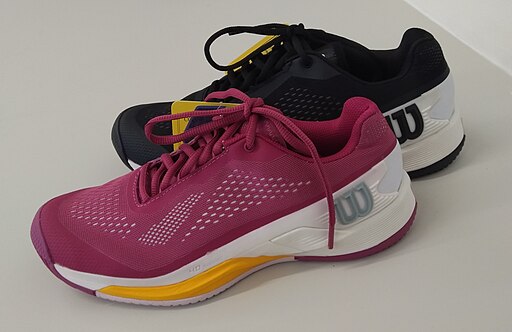Tennis shoes are designed for lateral movement and durability, while basketball shoes prioritize ankle support and cushioning for jumping and quick direction changes.
What are Tennis shoes?

Tennis shoes, also known as sneakers or athletic shoes, are specifically designed to support the rigorous movements and lateral footwork involved in playing tennis. These shoes prioritize stability, traction, and durability to help players maintain their balance during quick directional changes on the court.
The construction of tennis shoes features a supportive upper that secures the foot and provides stability during side-to-side movements. The outsole is typically made from durable rubber with herringbone or multidirectional patterns for excellent grip on various court surfaces.
Furthermore, cushioning plays a crucial role in tennis shoe design to absorb impact and reduce stress on joints. Extra padding is often placed in areas prone to high-impact landings like the heel and forefoot.
Additionally, many tennis shoe models incorporate features such as toe guards for added protection against abrasion during slides and reinforced midsoles for enhanced stability. They also tend to have a lower profile than basketball shoes since excessive ankle support can restrict movement required for swift changes in direction.
Tennis shoes offer players the necessary support, durability, traction, and cushioning needed to excel on the court. Now that we’ve covered what makes them unique let’s dive into what sets basketball shoes apart!
What are Basketball shoes?

Basketball shoes are specially designed footwear that provides the necessary support and stability for players during intense basketball games. These shoes are specifically engineered to enhance performance on the court while also protecting the player’s feet from potential injuries.
One key feature of basketball shoes is their high-top design, which extends above the ankle. This provides additional support and helps prevent sprains or twists during quick movements such as lateral cuts and jumps. However, there are also mid-top and low-top variations available for players who prefer different levels of ankle mobility.
Another important aspect of basketball shoes is their cushioning system. Since basketball involves a lot of jumping and running, these shoes often have advanced cushioning technologies like air pockets or foam inserts to absorb impact forces and provide optimal comfort.
Additionally, basketball shoes typically have a herringbone pattern on the outsole, which offers excellent traction on indoor courts. This helps players maintain grip while making quick turns or sudden stops.
Furthermore, durability is crucial in basketball shoes due to the rigorous nature of the sport. They need to withstand constant movement, pivoting, and sliding without wearing out quickly.
Basketball shoes are specifically designed with features that cater to the demands of this dynamic sport—providing stability, support, cushioning, traction—and ultimately improving a player’s performance on the court
Tennis Vs. Basketball Shoes – Key Differences between
| Characteristic | Tennis Shoes | Basketball Shoes |
|---|---|---|
| Sole Design | Designed for multi-directional movement, with durable, non-marking outsoles | Designed for quick lateral movements, jumping, and shock absorption, often with herringbone or multidirectional patterns |
| Ankle Support | Typically low-cut or mid-cut for freedom of movement | Often high-top for added ankle support and stability |
| Cushioning | Offers moderate cushioning for comfort and impact protection | Provides enhanced cushioning for jumping and landing |
| Upper Material | Made of lightweight, breathable materials for agility | Features a mix of supportive materials for durability and stability |
| Traction | Focuses on providing grip for lateral and forward-backward movements | Designed for quick stops, starts, and multidirectional changes |
| Weight | Lightweight to facilitate agility and speed | Heavier to accommodate the added features and ankle support |
| Game-Specific | Primarily for tennis, but can be used for other sports | Primarily for basketball, with a focus on basketball-specific movements |
| Outsole Pattern | Classic herringbone or modified patterns for varied court surfaces | Tread patterns may vary, designed for grip on indoor and outdoor courts |
| Durability | Emphasizes durability against abrasive court surfaces | Balances durability with performance features |
| Design Style | Often simple, sleek, and low-profile | Can be flashy and include signature player branding |
| Versatility | May be used for other court sports or casual wear | Primarily suited for basketball activities |
Types of Tennis Shoes: Clay Court, Grass Court, Hard Court
Clay Court Tennis Shoes
- Designed for clay or soft court surfaces.
- Features a non-marking, herringbone or modified tread pattern that provides good traction on loose and slippery clay.
- Typically lightweight with cushioning to minimize the impact of sliding.
- Offers lateral support to prevent ankle injuries during quick direction changes.
Features a full-length outsole to prevent clay from entering the shoe.
Grass Court Tennis Shoes
- Suited for grass court surfaces, such as Wimbledon.
- Characterized by a specific sole with small rubber studs or pimples that provide traction without damaging the grass.
- Designed to be lightweight and comfortable, ensuring good agility and grip on grass.
- Often have a more traditional and classic appearance.
Hard Court Tennis Shoes
- Ideal for hard, concrete, or asphalt court surfaces.
- Features an all-purpose outsole with a durable, non-marking design to withstand abrasive hard courts.
- Offers a balance of cushioning for shock absorption and lateral support for quick movements.
- Generally more versatile and can be used on various surfaces.Designed to provide durability and protect against the wear and tear of hard courts.
Selecting the appropriate tennis shoe type based on the court surface you regularly play on is essential to optimize your performance and extend the life of your footwear.
Types of Basketball Shoes: High Tops, Mid-Tops, Low Tops
High-Top Basketball Shoes
- High-cut design with extended collar that covers the ankle.
- Provides maximum ankle support and stability, reducing the risk of ankle injuries.
- Ideal for players who make frequent jumps, quick directional changes, and need enhanced support.
Mid-Top Basketball Shoes
- Middle-ground design with ankle collars that extend just above the ankle.
- Offers a balance between ankle support and freedom of movement.
- Suitable for players who want some ankle support but also value agility and range of motion.
Low-Top Basketball Shoes
- Low-cut design with ankle collars below the ankle.
- Provides the least ankle support but allows for greater flexibility and speed.
- Preferred by players who prioritize agility, quick movements, and prefer a lighter shoe.
- The choice of basketball shoe style depends on individual preferences, playing style, and the level of ankle support required. Professional athletes and casual players often choose different styles based on their specific needs on the court.
Image Credits
Featured Image By – Jjanhone, CC BY-SA 4.0, via Wikimedia Commons
Image 1 By – jose esqueda from Pixabay
Image 2 By – Keith Johnston from Pixabay








